Top PC Screen Recording Software for Professionals


Intro
In today’s fast-paced digital world, screen recording has taken center stage, especially for those involved in remote work and online content creation. Businesses, educators, and entrepreneurs require effective tools to capture, record, and present their ideas or tutorials seamlessly. Here, we’ll examine the spectrum of software available for these tasks on PC. By diving into the nitty-gritty aspects of various screen recording solutions, we hope to reveal insights that help users make informed decisions.
Software Overview
Prolusion to the software
The realm of screen recording software on PC is wide and varied. You’ll find options catering to different needs, from basic functionalities to advanced features designed for professional use. Each software has its unique selling points, making it essential to choose one that aligns with your specific requirements.
Key features and functionalities
When selecting the right screen recording software, consider the following key features:
- Recording Quality: The ability to capture high-definition footage is crucial for clarity.
- Platform Compatibility: Some software options may work better on certain operating systems, so it's wise to check.
- Editing Tools: Basic editing features can save time and enhance presentation quality.
- Recording Modes: Options such as full screen, window-based, or region-specific recording allow flexibility depending on the project.
Most renowned tools, like OBS Studio and Camtasia, inherently offer diverse functionalities, enabling users to tailor their setup based on specific tasks.
Pricing plans and available subscriptions
Pricing can significantly impact your decision. Many software options have unique pricing models:
- Free Versions: Such as ShareX, provide essential features without cost, albeit often without certain advanced functionalities.
- One-time Purchase: Tools like Camtasia offer a one-off payment, freeing users from monthly subscriptions.
- Subscription Plans: Software like Screencast-O-Matic offers monthly or annual subscriptions, which can be budget-friendly, especially for startups.
In this section, understanding how much you are willing to invest should guide your selection process.
User Experience
User interface and navigational elements
An intuitive user interface is often the hallmark of good screen recording software. You shouldn't need a PhD to navigate the software. Tools with complex interfaces can lead to frustration and hinder productivity. Modern software typically offers clear visual cues and straightforward navigation, making it easier for users to find their way around the features.
Ease of use and learning curve
Another significant aspect is the learning curve. While some may come packed with advanced features, a convoluted setup can deter users. A user-friendly software will often provide guided tutorials or helpful tips, making it less daunting. For instance, tools like Loom boast simplicity, allowing users to get started without diving deep into tutorials.
Customer support options and reliability
Customer support is crucial when issues arise. Look for software that offers responsive customer service through various channels, be it email, chat, or community forums. Reliable software should have meaningful online resources.
Performance and Reliability
Speed and efficiency of the software
When recording, no one wants lag or interruptions. Efficient software performs reliably in high-demand situations. Testing speed and efficiency can be done through user reviews or trials offered by the software itself.
Uptime and downtime statistics
It’s important to research the uptime history of the software you are considering. Frequent downtimes can lead to risk of losing valuable recordings. Reliable software typically boasts high uptime percentages, giving peace of mind to its users.
Integration capabilities with other tools
Screen recording often complements other software. For example, integrating with video editing software can enhance your post-production efforts. Ensure the tool of choice works well with your existing systems and the other tools you utilize in your workflows.
Security and Compliance
Data encryption and security protocols
User data and recorded content must be safeguarded against potential threats. Look for software that employs robust encryption methods and follows industry best practices for data security. A lack of security can lead to vulnerabilities, especially when handling sensitive information.
Compliance with industry regulations
Make sure the screen recording software meets any compliance requirements relevant to your industry. Regulations like GDPR can affect how you manage recorded data, especially if it involves personal conversations.
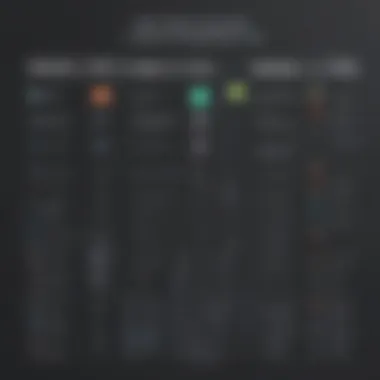
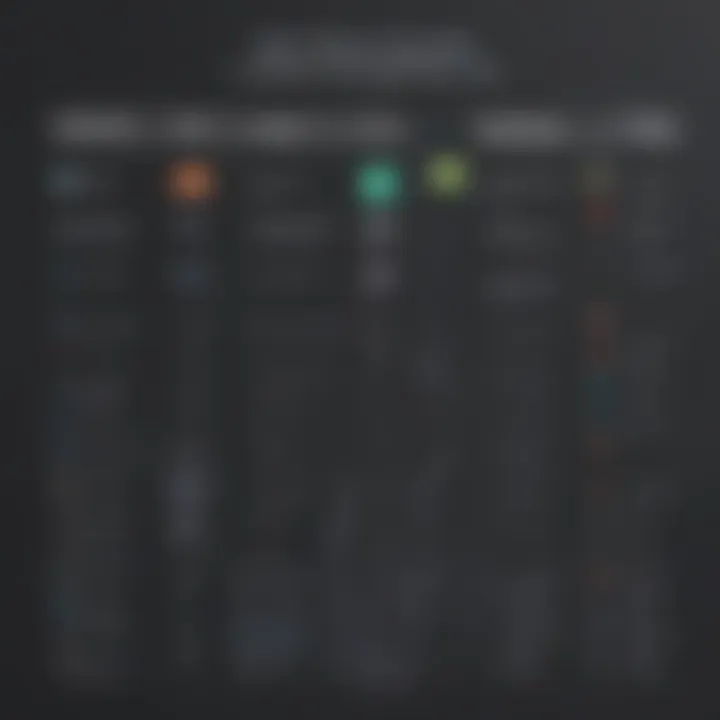
Backup and disaster recovery measures
Accidental data loss can be a nightmare. Choose software that offers reliable backup options and a clear disaster recovery process. Regular backups ensure that your hard work remains safe and sound.
Choosing the right screen recording software is not just about functionality; it's a matter of ensuring the reliability, security, and user-friendliness align with what you need for effective communication and presentation.
Understanding Screen Recording Software
In an increasingly digital world, understanding screen recording software has become vital for various professionals, including small business owners, entrepreneurs, and IT experts. The ability to effectively capture activities on a computer screen isn’t just a luxury anymore; it’s a necessity. Whether it’s for instructional videos, software tutorials, product demonstrations, or remote collaboration, screen recording tools address a myriad of needs.
Screen recording software allows users to produce visual content that can convey information more effectively than words alone. This is especially important in a business context, where clarity and engagement are key to successful communication. By visualizing tasks or processes, organizations can enhance learning experiences, streamline onboarding, and ensure consistent knowledge sharing. This software can help reduce misunderstandings that often arise in text-based communication.
When choosing a screen recording tool, a business owner should consider several key aspects. Factors such as ease of use, quality of output, and availability of editing features can significantly impact the effectiveness of the final product. Moreover, compatibility with different operating systems and devices will influence the software that best fits a user's needs. As the demand for engaging content continues rising, mastering screen recording software becomes not just a skill but an essential asset.
What is Screen Recording Software?
Screen recording software enables users to capture a video of their computer screen, including any actions or movements made with the mouse and keyboard. At its core, the software records everything that's happening on the display, including windows being opened or closed, applications being used, and even web pages being navigated.
Unlike traditional video recording methods that rely on external hardware, this software requires nothing more than the computer itself, making it a budget-friendly option for many. Different programs offer various functionalities, from basic recording features to advanced options like real-time editing and live streaming capabilities.
Key Features of Effective Screen Recording Tools
Not all screen recording software is created equal. Here are some critical features to consider:
- User-Friendly Interface: A simple layout can save time and reduce frustration, especially for first-time users.
- Recording Quality: The software should allow for high-resolution capture. Consistent video quality is essential for professional output.
- Audio Options: The ability to record internal audio (from the system) and external audio (from a microphone) is vital for most applications.
- Editing Tools: Post-recording editing capabilities, allowing users to trim, cut, annotate, or add effects, are important for creating polished content.
- Export Formats: Support for various file formats will enable flexibility in sharing and using the recorded content.
Common Use Cases for Screen Recording Software
Screen recording software finds applications across numerous fields:
- Education: Instructors can create video lectures or tutorials to supplement teaching materials, helping students understand complex topics visually.
- Corporate Training: Organizations can develop training materials that are consistent and easily updated, leading to efficient onboarding processes.
- Marketing: Marketers often use screen recordings for demo videos, showcasing products or services in action.
- Technical Support: Providing visual guides for troubleshooting equips users with the necessary understanding to solve their issues independently.
- Content Creation: Creators can produce gameplay videos, software reviews, or professional webinars, tapping into the vast market of online content.
Understanding screen recording software provides insights not just into features but also into the practical uses that can drive a business forward in myriad ways.
Criteria for Selecting Screen Recording Software
When navigating the sea of options in screen recording software, it's essential to pinpoint the criteria that can differentiate the great from the mediocre. With screen recording becoming a crucial tool in the toolbox of businesses, entrepreneurs, and IT professionals, understanding these selection criteria can streamline the decision-making process. A good software should not only record your screen but must also offer a balanced mix of usability, features, and cost-effectiveness.
User Experience and Interface Design
No one likes to wrestle with a clunky interface, especially not busy professionals. A user-friendly design is paramount. When thumbing through various software, look for clean layouts, intuitive menus, and streamlined workflows. An application that forces the user to navigate multiple layers just to start recording can turn a simple task into a chore.
Consider software that employs drag-and-drop features for easy video import and straightforward exporting options. For instance, OBS Studio stands out for its customizable interface, allowing users to arrange their workspace to suit their recording style. The interface significantly impacts how efficiently one can operate the software during crucial moments.
Video Quality and Compression Options
The essence of screen recording lies in the quality of the output. Poor video clarity can muddy even the most engaging content. Thus, look for software that supports high-definition recording—1080p should be a standard minimum nowadays. Compression options are equally important; they help balance quality and file size, ensuring that high-resolution videos don't consume excess storage.
For instance, Camtasia excels here as it allows you to tweak video settings while maintaining quality. The ability to select bit rates and frame rates plays a big role in this. You don't want your six-hour webinar reduced to grainy nothingness in post-processing.
Audio Recording Features
Many screen recordings benefit from clear audio—voiceovers can enhance engagement and understanding. Look for tools boasting multi-channel audio capabilities to capture sound from various sources. A system that allows for separate audio tracks can be incredibly beneficial. It allows users to record system sound, microphone input, or both independently.
Tools like Bandicam offer professional sound recording features, catering to those who prioritize audio as much as the visual elements. Also, be sure to check for noise suppression technology, which can greatly improve the clarity of your recordings, particularly in a less-than-quiet environment.
Editing Capabilities Post-Recording
Recording is only half the battle; editing is where you shape the final product into something polished. Great screen recording software should come with robust editing features or integrate easily with dedicated editing applications. Look for tools that allow for trimming, adding annotations, or including overlays. Certain softwares, like Snagit, enable quick editing right after recording. This immediacy can save a lot of time and keeps your workflow continuous.
Compatibility with Different Operating Systems
In today’s diverse digital landscape, compatibility can’t be overlooked. You want software that runs seamlessly across platforms like Windows and Mac OS. Ensure that the tool works effectively regardless of your operating system. Software like ScreenFlow is macOS-specific, while alternatives like OBS Studio run smoothly on both. Understanding the compatibility landscape prevents wasted time in testing various applications, ensuring a smooth recording experience for everyone involved.
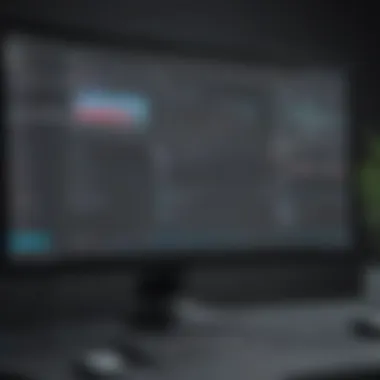
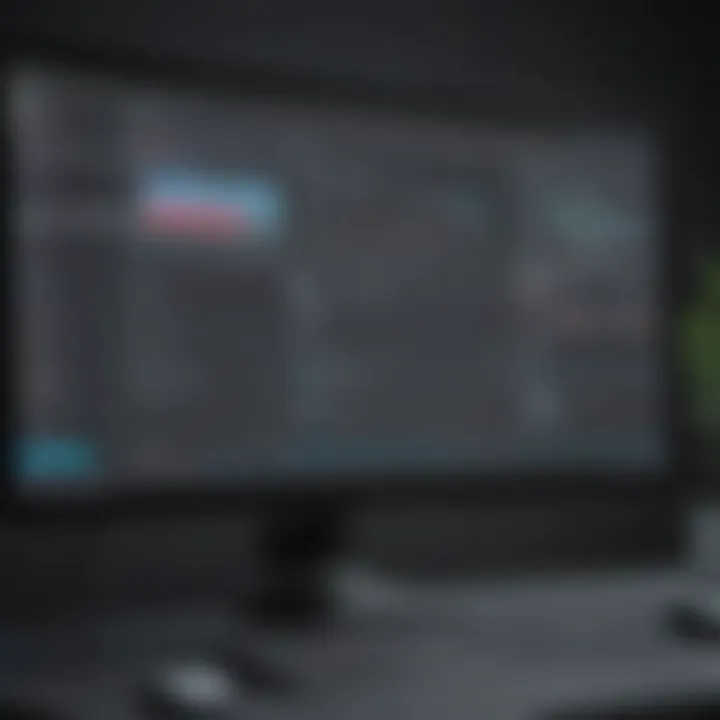
Cost Considerations and Licensing Models
Lastly, no decision is complete without considering costs. From free software with limited capabilities to professional-grade options with hefty price tags, the marketplace is flooded with choices. Evaluate the licensing models as well; some programs offer subscriptions while others are one-off purchases.
Look closely at what features are included in these packages. For instance, Camtasia might be pricier but includes comprehensive editing features. Understand what you're getting; don’t just focus on the bottom line. You’ll want to assess long-term costs versus immediate needs.
"The most significant challenge isn’t acquiring the right tools but selecting those that align with your specific needs."
In summation, when picking out screen recording software, every detail matters—from interface design to pricing. Prioritizing these criteria ensures you end up with a tool that works for your unique situation, providing efficient solutions for your recording needs.
Top Software for Screen Recording in PC
When it comes to capturing the digital canvas of a PC, the right software can make all the difference. This section delves into top-tier options that users can consider for screen recording needs. Each software has unique advantages which cater to varied user requirements, whether it’s for enhancing online presentations, documenting software tutorials, or creating engaging video content.
Selecting the best software isn't just about features; it's about finding a tool that aligns with specific workflows. Different functionalities like intuitive interfaces, flexibility in video resolutions, and even the ability to record from multiple sources come into play. The software you choose should support your goals and streamline your process, saving time and effort in content creation.
OBS Studio – A Free and Versatile Option
OBS Studio stands out as a powerhouse for screen recording and live streaming. As an open-source platform, it offers a cost-effective solution without skimping on features. Users can capture their screen, webcam, and audio effortlessly. What’s enticing is flexibility in settings; it allows customization of video and audio sources to suit individual needs. This versatility makes it a favorite among streamers and educators alike.
Since it’s constantly updated by a community of developers, new functionalities and fixes come regularly. OBS Studio also supports plugins, which can add even more features. This option shines brightly, especially for those starting out or needing something reliable that won’t hurt their wallet.
Camtasia – Enhanced Editing Features
Camtasia is often hailed as more than just screen recording software. It’s a complete video editing suite. For users who need polished content, Camtasia provides a user-friendly interface that simplifies the editing process. Here, you can trim, caption, and even add interactive elements to videos.
The step-by-step tutorial options help ease the learning curve, making it ideal for those less tech-savvy. The library of music tracks and sound effects available in Camtasia can elevate the quality of the final product without additional costs. Many find its ability to combine screen recordings with presentations truly beneficial for business needs.
Snagit – User-Friendly Design
Snagit, developed by TechSmith, is recognized for its simplicity and ease of use. Designed primarily for quick captures, it enables users to record their screen or take screenshots within moments. Its drag-and-drop functionality enhances the efficiency of creating visual content, making it suitable for anyone needing fast results.
Snagit offers basic editing tools to polish screenshots and videos before sharing. It’s particularly handy for creating instructional materials or sharing quick updates with a team. This software caters to users who want a straightforward, no-frills approach without sacrificing quality.
Bandicam – High-Quality Recording
For those focused on high-quality video output, Bandicam excels. It supports recording in resolutions up to 4K, ensuring crisp visuals that capture every detail. This is particularly beneficial for gamers or professionals demonstrating software applications at their best.
Its compression technology means that users can achieve high-quality recordings while managing file sizes effectively. Additionally, Bandicam features a user-friendly interface with straightforward game recording options, attracting gamers and tutorial creators alike. The investment in this software pays off with the quality it delivers.
ScreenFlow – Comprehensive Suite for macOS
ScreenFlow is a favorite among Mac users, celebrated for its seamless integration with macOS. It goes beyond basic recording functions to offer a suite of editing tools. ScreenFlow allows users to record their screens, web cameras, and audio simultaneously.
The editing capabilities are relatively advanced, allowing users to edit their content post-recording easily. Features like green screen effects and motion graphics add flair to videos. Content creators who operate primarily on Macs often prefer ScreenFlow for its robust features and intuitive layout.
CamStudio – Open Source Solution
CamStudio is another open-source software that provides a basic yet effective screen recording solution. While it may not have all the bells and whistles found in premium software, it serves its purpose well. Users can record screen activity and add annotations, a feature particularly valuable for educational content.
Though it lacks the advanced features that some users may expect, CamStudio is free and suitable for users who need essential functionalities and are comfortable with a more simplified experience. The community behind CamStudio ensures ongoing support and updates, allowing users to keep pace with any technological changes.
In choosing screen recording software, it’s essential to weigh features against your specific needs. Be it the complexity of editing tools or high-resolution recording capabilities, a thoughtful approach will lead to a more satisfying user experience.
Comparison of Leading Screen Recording Tools
In the labyrinth of digital media, the right screen recording software can be the beacon that guides you through the creative process. When it comes to choosing a software solution, it's crucial to evaluate available options based on various features, usability, and cost-effective elements. A thorough comparison of leading screen recording tools not only helps to identify strengths and weaknesses but also aligns with your specific needs and workflow.
For small to medium-sized businesses, entrepreneurs, and IT professionals, this analysis can lead to more informed decisions that elevate content quality and enhance productivity. By understanding how different tools stack up against one another, users can avoid the potential pitfall of investing time and resources into software that may not meet their requirements. In essence, it’s about finding the right fit—like a well-tailored suit, it should feel just right without compromising on functionality.
Feature Comparison Table
When you look at screen recording tools, features can make or break the experience. Here's a simplified overview of how some leading software options measure up in terms of critical features:
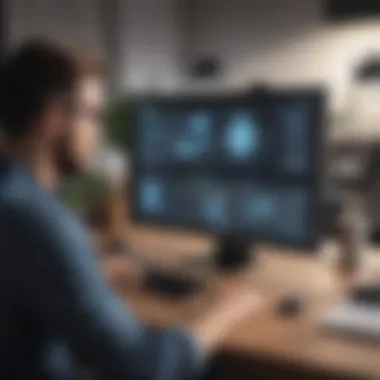

| Software | Recording Quality | Editing Tools | Audio Capture | Multi-Screen Support | Price | | OBS Studio | High | Basic | Yes | Yes | Free | | Camtasia | 4K | Advanced | Yes | Yes | $249 | | Snagit | Full HD | Basic | Yes | Limited | $62.99 | | Bandicam | 4K | Limited | Yes | Yes | $39.95 | | ScreenFlow | High | Comprehensive | Yes | macOS only | $149 | | CamStudio | Full HD | None | Yes | No | Free |
The table above indicates that while some software come at a cost, they may also provide advanced functionalities that justify the investment. On the other hand, free options offer easy entry points for startups and educators, though they may lack the depth found in pricier alternatives. Importantly, evaluating features relevant to your specific usage scenario is key—consider what you’re trying to achieve.
Cost vs. Features Analysis
The relationship between cost and features in screen recording software is essential to navigate, especially if you’re on a budget. While it may be tempting to opt for the cheapest solution, often you get what you pay for. Missing advanced features can lead to inefficiencies in your work. Let’s break down some considerations:
- Budget Constraints: Small businesses often operate under tight financial guidelines. It's important to strike a balance between cost and needs.
- Long-Term Value: Sometimes spending a bit more up-front might save time and enhance the quality of your work in the long run. Consider the ease of use and support offered by the provider.
- Training and Adaptation Costs: Cheaper options might be intuitive but could have hidden costs in terms of training staff versus investing in a tool that is more feature-rich, which might ultimately be user-friendly.
"The best investment is in yourself. The more you learn, the more you earn." – Warren Buffett
- Trial Periods: Many software solutions offer trial periods. Take advantage of this to evaluate their fit for your workflow before committing.
Overall, understanding these elements will not only refine your selection but will ultimately enhance your productivity and the quality of your recording endeavors. A sensible approach considers both immediate and future needs, ensuring that your software choice is a smart investment now and down the line.
Best Practices for Screen Recording
In a world where digital content rules the roost, knowing how to effectively record your screen can make all the difference. Best practices for screen recording are not just tips; they’re essential ingredients for producing high-quality, engaging videos. Whether you’re creating tutorials, conducting a webinar, or documenting processes, following these best practices can enhance your credibility and improve the viewer experience. By understanding how to prepare your environment, apply suitable recording techniques, and polish your content in editing, you ensure your recordings stand out amidst the noise of countless online videos.
Preparing Your Screen and Environment
Before hitting that record button, it's vital to get your screen and environment ready. A clean workspace, both in terms of visual distraction and computer clutter, sets the tone. Close any unnecessary tabs or applications—this not only ensures optimal performance but also keeps your viewer focused on the content that matters.
Some tips to consider include:
- Desktop Background: Create a professional or neutral desktop background. This helps to avoid distracting visuals.
- Notification Settings: Silence notifications to keep interruptions at bay. An unexpected pop-up can derail even the best presentations.
- Lighting and Sound: Ensure your recording area is well-lit and quiet; sound quality can make or break your content. If you’re using a webcam, good lighting can improve your video quality significantly.
- Screen Resolution: Set your screen resolution to match your recording software settings. Recording in a higher resolution can make your content more appealing but remember to balance this with the file size for sharing.
These elements collectively contribute to a seamless viewing experience. Don’t underestimate the power of a tidy screen and peaceful environment; they pave the way for a smoother recording process.
Recording Techniques for Clarity and Engagement
When the record light is on, how you present your content matters a great deal. Fumbling through a presentation with unclear speech can lead to viewer disengagement. To keep your audience captivated, consider these techniques:
- Structured Flow: Outline your key points beforehand. Make sure your narration has a logical flow.
- Pacing: Speak slowly and clearly. Rushing through content might confuse viewers, especially if the subject matter is complex.
- Visual Aids: Use annotations, cursor highlights, or callouts to draw attention to specific elements on your screen. This helps in keeping viewers engaged.
- Interactive Elements: If the software allows, include quizzes or polls. These interactive elements can keep the audience on their toes and interested in what’s next.
Remember that engaging content not only delivers information but also keeps the audience thinking or participating actively.
Editing Tips for Final Touches
After the recording is done, the editing process is where your video takes its final shape. A good edit can enhance professionalism and make your video more enjoyable. Here are some editing tips:
- Cut Out Mistakes: Don’t hesitate to trim any mistakes, long pauses, or irrelevant sections. Your aim is to keep the content tight and engaging.
- Add Enhancements: Consider adding background music or sound effects—just make sure they don’t overpower the narration. Small details can drastically improve the viewer experience.
- Subtitles and Captions: For accessibility, adding subtitles can help a wider audience understand your content. This is especially useful for non-native speakers.
- Review and Preview: Always preview your final edit. Watching it as your audience would can help catch any last-minute issues.
"Editing is where the magic happens. It turns a simple recording into a polished product that speaks to your audience."
Incorporating these practices into your screen recording process equips you to produce high-quality videos that resonate with viewers, regardless of your purpose. It’s not just about recording; it’s about crafting an experience that informs, engages, and entertains.
Future Trends in Screen Recording Technology
In the fast-paced world of technology, the landscape of screen recording software is continuously evolving. Staying up-to-date with trends not only helps users select the right tools but also prepares them for what lies ahead. As digital content creation becomes more complex and widespread, several key trends are taking shape in the screen recording arena. These advancements promise enhanced functionality, improved user experience, and greater efficiency—all essential factors for small to medium-sized businesses, entrepreneurs, and IT professionals.
Incorporation of AI in Screen Recording Tools
Artificial Intelligence (AI) is making strides in various domains, and screen recording software is no exception. With the growing need for speed and convenience, AI integration enables users to simplify their recording processes. Imagine not having to fiddle around with settings or figure out optimal recording angles—AI can help with that!
- Smart Editing: AI-driven editing tools can not only analyze recorded footage but also suggest edits based on user preferences. This means that users with limited video editing experience can still produce professional-looking content.
- Voice Recognition: Some applications are beginning to incorporate voice-to-text capabilities for improved accessibility. This feature allows users to create subtitles or transcripts automatically, catering to a broader audience and enhancing engagement.
- Quality Enhancement: AI algorithms can enhance video quality dynamically, adjusting for various conditions like lighting or network speed during live streams.
By automating mundane tasks and optimizing recording quality, the incorporation of AI allows users to concentrate more on content creation rather than technical details.
Emerging Features to Watch For
As technology continues to advance, several noteworthy features are expected to gain traction in screen recording software:
- Cloud-Based Storage: Many users now prefer cloud solutions for storage, allowing access from anywhere. This trend is creating a shift away from local storage, giving way to collaborative features, where multiple users can work on projects simultaneously. Cloud integration can greatly streamline sharing and collaboration.
- Interactive Recordings: Tools that enable users to create interactive recordings are on the rise. This includes clickable elements that allow viewers to engage with the recording actively, making the content more dynamic and collaborative.
- Multi-Platform Syncing: As people use multiple devices, the demand for applications that support seamless transitions between platforms is growing. Users want the ability to start a recording on their laptop and easily continue on their tablet.
- Simplified User Interfaces: With so many features packed into software nowadays, a clean and intuitive interface is becoming essential. Users are looking for tools that make it easy to navigate complex options without overwhelming them.
These emerging features not only enhance functionality but also empower users to produce high-quality content efficiently. As the market adapts, understanding these trends can help professionals stay ahead of the curve, ensuring they utilize tools that match their growing needs.
Staying informed about the advancements in screen recording technology can elevate the effectiveness and quality of your digital content.







